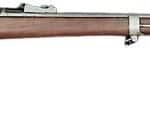
Introduction to the Fusil Gras Modèle 1874: A Definitive Evolution in French Military Firearms
The Fusil Gras Modèle 1874 was a landmark firearm in the history of the French military, representing a crucial step in the transition from paper-cartridge, needle-fire rifles to modern metallic-cartridge bolt-action designs. Its development was driven by the lessons of the Franco-Prussian War (1870-1871), during which the shortcomings of the Chassepot Model 1866 became evident. While the Chassepot was a formidable weapon in its own right, its reliance on combustible paper cartridges made it vulnerable to battlefield conditions, leading to fouling, reliability issues, and logistical complications.
The defeat of France by Prussian forces, who increasingly adopted metallic cartridge rifles like the Mauser Model 1871, underscored the necessity of upgrading French armament. In response, Colonel Basile Gras led the redesign of the existing Chassepot platform, creating a rifle that retained its predecessor’s general form but was adapted to fire self-contained centerfire metallic cartridges. Officially adopted in 1874, the Fusil Gras became France’s first true metallic cartridge service rifle, offering improved durability, ease of maintenance, and superior reliability under combat conditions.
Design and Mechanical Enhancements
The Fusil Gras rifle was fundamentally based on the Chassepot Model 1866, but its internal mechanics were reworked to accommodate the higher pressures and reliability of metallic cartridges. Several key modifications distinguished it from its predecessor:
Bolt and Extraction Mechanism
- The Gras retained the Chassepot’s bolt-action mechanism but eliminated the rubber obturator and complex gas-sealing system designed for paper cartridges.
- It introduced a hardened steel bolt head that provided a more robust locking system, ensuring that it could withstand the higher pressures generated by smokeless powder adaptations in later years.
- A stronger extractor was incorporated to improve spent cartridge removal, reducing malfunctions and making operation smoother and more reliable.
Barrel and Chamber Adjustments
- The barrel was rifled with four-groove, right-hand twist rifling, optimized for the 11mm Gras cartridge.
- The chamber was reconfigured to accommodate the rimmed metallic case, ensuring better gas sealing and reduced fouling.
- The receiver was strengthened to improve structural integrity, making the rifle capable of handling higher pressures, particularly in later M80 smokeless powder conversions.
Sights and Ergonomics
- The rifle was fitted with adjustable ladder-style rear sights, allowing for ranged fire up to 1,200 meters, though practical combat accuracy was best at 300-400 meters.
- A fixed front sight blade provided a simple but effective aiming system.
- The stock was made from walnut, designed to withstand rough battlefield use while maintaining stability during firing.
Specifications
- Overall Length: 1,310 mm (51.6 inches)
- Barrel Length: 851 mm (33.5 inches)
- Weight: 4.2 kg (9.3 lbs)
- Caliber: 11×59mmR Gras
- Action: Single-shot, bolt-action
- Muzzle Velocity: ~450 m/s (1,480 ft/s)
- Effective Range: 800 meters
- Maximum Range: 1,200 meters
These refinements made the Fusil Gras rifle significantly more reliable in battlefield conditions, especially when compared to the fragile Chassepot, and brought French military firearms in line with contemporary European developments.
The 11×59mmR Gras Cartridge: A Pioneering Step in Ammunition Development
One of the most critical advancements introduced with the Fusil Gras rifle was its 11×59mmR Gras cartridge, which marked a complete departure from paper cartridges. This centerfire metallic cartridge provided superior ballistic performance, reduced fouling, and allowed for faster reloading. Key attributes of the cartridge include:
- Case Type: Rimmed, bottlenecked
- Case Material: Brass (early models used copper alloy)
- Bullet Weight: ~25.3 grams (390 grains)
- Powder Charge: ~4.8 grams (74 grains) of black powder
- Velocity: ~450 m/s (1,480 ft/s)
- Energy: ~1,600 joules
The transition to metallic cartridges greatly improved battlefield efficiency, as it simplified logistics and maintenance while reducing the risk of misfires. This placed France ahead of many nations still relying on needle-fire or early breechloading systems.
The M80 modification, adopted around 1879–1880, refined the sights and cartridge for the 11×59R black-powder load, improving ballistic consistency and accuracy. True smokeless-powder service came later, when some Gras and Chassepot-Gras rifles were rebuilt to fire the 8×50R Lebel cartridge. This extended the Gras’ operational lifespan, allowing it to serve well into the 20th century.
Service History: Global Deployment and Influence
While the much-anticipated rematch with Germany did not occur during the Gras’s frontline career, the M1874 and M80 rifles saw extensive service in France’s colonial campaigns in North Africa and Indochina, and later reappeared in World War I in second-line and territorial units.
The Fusil Gras Modèle 1874 quickly became the primary service rifle of the French military and saw extensive deployment across multiple conflicts:
French Colonial Wars
- Sino-French War (1884-1885) – Fielded by French forces in Indochina.
- First Madagascar Expedition (1883-1885) – Supplied to colonial forces.
- Tonkin Campaign (1883-1886) – Saw action in Vietnam as part of French expansion in Southeast Asia.
World War I (1914-1918)
- While the Lebel Model 1886 had replaced it as the standard infantry rifle, the Gras was widely used by colonial forces, reserves, and rear-echelon troops.
- Many were converted into grenade launchers or reissued to auxiliary units.
Greek Military Adoption and the Balkan Wars
- Greece purchased large quantities of Gras rifles in the late 19th century.
- They saw action in the Balkan Wars (1912-1913) and World War I, often modified to fire spitzer-type bullets.
- Some remained in use during World War II, particularly in resistance efforts against Axis forces.
The continued use of the Gras decades after its adoption speaks to the quality and durability of its design.
Legacy and Influence on Later Rifles
The Gras rifle played a pivotal role in the evolution of bolt-action firearms. Key influences include:
French Lebel Model 1886 – Introduced smokeless powder and an eight-round tubular magazine, making single-shot rifles like the Gras obsolete.
Berthier Rifle Series – Some design features of the Gras were incorporated into Berthier rifles, used by the French military through both World Wars.
Mannlicher and Mauser Developments – The success of metallic cartridges in the Gras system encouraged further bolt-action refinements in Europe.
Even after military service, thousands of Gras rifles were converted into hunting firearms or civilian shotguns, ensuring their continued use well into the 20th century.
Conclusion: The Enduring Legacy of the Fusil Gras Modèle 1874
The Fusil Gras Modèle 1874 was a milestone in firearm evolution, bridging the gap between early breechloaders and modern bolt-action rifles. Its adoption of metallic cartridges, robust construction, and service longevity established it as one of the most influential rifles of the late 19th century.
While it was eventually replaced by magazine-fed, smokeless powder rifles, the Gras remained in use for decades in conflicts across Europe, Africa, and Asia. Its legacy lives on as a testament to French innovation in firearms technology, influencing generations of military rifles that followed.
By addressing the shortcomings of the Chassepot and embracing metallic cartridges, the Fusil Gras Modèle 1874 helped define the trajectory of modern military arms development—a true landmark in the history of bolt-action firearms.
Read more about French military rifles here:

If you know of any forums or sites that should be referenced on this listing, please let us know here.




